An Integrative Approach to the Study of Cognitive Abilities in a Non-Human Primate Model in a Virology Laboratory Environment
Abstract
1. Introduction
2. Materials and Methods
2.1. Animals and Special Conditions
2.2. Experimental Design
2.3. The “Confidence” Methodology
- In the first stage, to initiate contact between the primate and the experimenter, it was necessary to approach the primate’s cage carefully, without startling the primate with sudden movements, and place a treat on the edge of the cage so that it would not fall off. The experimenter then exited the testing room or moved out of the primate’s line of sight. The primate needed to overcome stress and take the treat. If successful, a score of 1 point was awarded.
- If the primate successfully completed Item 1, the next task was to take the treat from the edge of the cage in the presence of the experimenter. For this, all the actions of the previous item had to be repeated, but with the experimenter remaining in the testing room within the primate’s line of sight, placing the treat on the edge of the cage, and then stepping back a few meters and waiting. If successful, a score of 2 points was awarded.
- In order to implement the next stage, a removable platform with a flat and non-slip surface was required, which was set up in front of the animal’s cage so that the primate could freely manipulate objects on its surface. After installing the platform, a treat was placed on it; then, the experimenter stepped back, and the primate had to take the treat. If successful, a score of 3 points was awarded.
- In order to implement the following stage, a removable platform was also required. After setting up the platform, three cups were arranged on it in a row, and a treat was put in one of them; then, the experimenter exited the testing room or moved out of the primate’s line of sight. The test was considered successfully completed if the primate took the treat. If successful, a score of 4 points was awarded.
- The next task for the primate was to take the treat from the platform in the presence of the experimenter. If successful, a score of 5 points was awarded.
- The primate was required to complete Item 4, but in the presence of the experimenter. If successful, a score of 6 points was awarded.
- The final stage was a task where the primate had to take a treat from the hand of the experimenter. For this, it was necessary to carefully approach the primate’s cage and extend the treat so that the primate could freely reach it. If successful, a score of 7 points was awarded.
2.4. Behavioral and Cognitive Tests
2.4.1. Test 1: The “Tool Use and Properties” Battery—Study of Cognitive Abilities Based on the Primate Cognition Test Battery (PCTB)
- The “Three Cups” test. In this test, in front of each primate’s cage, three identical cups were posed in a row with a treat in one of them (random choice). The primate could easily see the treat. The aim of the test was for the primate to choose a cup with a treat from the first try. A successful outcome scored 1 point. A test was not successful when the primate chose a cup without a treat. This test is necessary for teaching object operation on the platform, with the aim of gradually increasing the complexity of the tasks. The test is similar to “Item 6” in the Confidence battery.
- The “Tool Use: Pulling Cloth with Treat” test (Figure 2). For the second test, the primates had to get the treat by pulling a piece of cloth. A piece of cloth (30 cm × 15 cm) with a treat on its end was posed so that the primate could reach the cloth, but the treat was rather far away from the monkey, such that it could not grab the treat with its paw. The primate had to use the tool to get the treat with it. The aim of the test was to demonstrate the ability to manipulate objects outside the cage and understand the spatial relationship between objects. A successful outcome scored 2 points.
- 3.
- The “Tool Properties: Pulling a Thread with a Treat “ test. In this test, a thread of 15 cm was placed on the platform of the cage with the treat on its end. The primate had to pull the thread (use the tool) to get a treat, demonstrating the ability to manipulate objects outside the cage. A successful outcome scored 2 points.
- 4.
- The “Tool Properties: Whole and Cut Threads with a Treat” test (Figure 3). In this stage of the training, the primate had to choose one of two threads (15 cm). One thread was cut into two pieces and the other thread was whole. There were treats at the ends of both threads. The research objects were blocked from view by a barrier and the animal did not know on which thread each treat was. The primate could not reach the treats with its paw. After taking away the barrier, the primate could only get a treat by pulling the unbroken thread, demonstrating the ability to manipulate objects outside the cage and understand the properties of objects. A successful outcome scored 4 points. If the primate chose the wrong thread on the first attempt, the experiment was stopped. The threads were totally the same in terms of color, length, and material.
2.4.2. Test 2: The “Memory” Battery—Study of Cognitive Abilities Based on PCTB
- The “Sticker Cup” test (Figure 4). There were three overturned cups put in a row on the platform in front of the testing cage. One of the cups had a white sticker on it. The experimenter showed the primate under which cup he put the treat and marked it with a white sticker. The aim of the experiment was to choose the right cup. A second choice was not given to the primate if it could not choose the right cup the first time. The experiment was successful when the primate chose the cup with the white sticker on the initial try. During the training sessions, it was crucial to solidify the primate’s connection between the sticker and the treat. A successful outcome was awarded 1 point.
- 2.
- The “Spatial Memory: 3 Upside Down Cups and 1 Treat” test. The experimenter prepared three identical cups and put them on a platform in a row in front of the cage. All the cups were overturned. A treat was placed under one of the cups (random choice) for the primate, which was shown to it. The animal could see the cups and had to choose the one with a treat under it. If the primate chose an empty cup, it did not have a second chance during the same experiment. A correct answer was accepted only on the first try. This demonstrated the capabilities of spatial memory and concentration on an object. A successful outcome was awarded 2 points.
- 3.
- The “Memory and Associations: Sticker Cup and a Barrier” test. This test was given to primates who could successfully pass the “Sticker Cup” test. Three overturned cups were put in a row in front of the cage and were hidden with a barrier. One of the cups had a white sticker on it. A treat was put under the cup marked by the sticker. As the primate already had experienced an experiment with cups and stickers, it was supposed to have formed and reinforced the association of the treat with the cup marked with a sticker. When the barrier was removed, the primate could choose the cup. In cases wherein the animal chose a cup without a white sticker, it was not allowed to make a second choice. The experiment was successful when the primate chose the cup with the sticker on the first try, thereby demonstrating a reinforced memory trace of the object. A successful outcome was awarded 4 points.
2.4.3. Test 3: The “Box”—Research Activity
2.4.4. Test 4: The “Reaction to a New Object”—Research Activity
2.4.5. Test 5: The “Tiredness” Battery—Tiredness and Performance Capacity
2.5. Statistical Analysis
3. Results
3.1. The Confidence Methodology
3.2. Behavioral and Cognitive Tests
3.2.1. Test 1: The “Tool Use and Properties” Battery—Study of Cognitive Abilities Based on the Primate Cognition Test Battery (PCTB)
3.2.2. Test 2: The “Memory” Battery—Study of Cognitive Abilities Based on PCTB
3.2.3. Test 3: The “Box”—Research Activity
3.2.4. Test 4: The “Reaction to a New Object”—Research Activity
3.2.5. Test 5: The “Tiredness” Battery—Tiredness and Performance Capacity
3.3. Searching for a Correlation between Successful Completion of the Confidence Test Tasks and Subsequent Success in Behavioral Tests
3.4. The Influence of Cage Location on Confidence in the Experimenter and the Research Activity of Primates
3.5. Comparison of Primates by Sex in Behavioral Tests and in the Confidence Test
4. Discussion
5. Conclusions
- Overall, the proposed upgraded methodologies provide a robust framework for the comprehensive assessment of primate cognition and behavior. These methods facilitate the effective training of long-tailed macaques, ensuring reliable and meaningful experimental results.
- The “Confidence” methodology can be used to make a qualitative selection of working primates into an experimental group.
- The simplified version of the “Tool Use and Properties” cascade proved its effectiveness in assessing primates’ understanding of objects and their properties and their spatial and causal relations.
- The enhanced “Memory” cascade provided an accurate assessment of primates’ memory and attention.
- The “Box” test was demonstrated to be an effective method to evaluate the skills of primates used to solve intellectual tasks.
- The upgraded “Reaction to a New Object” methodology enabled the study of primates’ exploratory activity, reaction latency, and attentional focus.
- The “Tiredness” test evaluates primates’ efficiency and tiredness without additional tests or medical procedures.
- Routine medical procedures did not significantly affect the cognitive abilities or behavior of long-tailed macaques.
- Cage positioning affects primates’ research activity and trust in the experimenter.
- No significant statistical differences were found between male and female primates in the proposed tests of cognitive performance.
Supplementary Materials
Author Contributions
Funding
Institutional Review Board Statement
Informed Consent Statement
Data Availability Statement
Acknowledgments
Conflicts of Interest
References
- Schmitt, V.; Pankau, B.; Fischer, J. Old World Monkeys Compare to Apes in the Primate Cognition Test Battery. PLoS ONE 2012, 7, e32024. [Google Scholar] [CrossRef]
- Tia, B.; Viaro, R.; Fadiga, L. Tool-Use Training Temporarily Enhances Cognitive Performance in Long-Tailed Macaques (Macaca fascicularis). Anim. Cogn. 2018, 21, 365–378. [Google Scholar] [CrossRef] [PubMed]
- Carson, P.J.; Konewko, P.; Wold, K.S.; Mariani, P.; Goli, S.; Bergloff, P.; Crosby, R.D. Long-Term Clinical and Neuropsychological Outcomes of West Nile Virus Infection. Clin. Infect. Dis. 2006, 43, 723–730. [Google Scholar] [CrossRef] [PubMed]
- Damiano, R.F.; Guedes, B.F.; De Rocca, C.C.; De Pádua Serafim, A.; Castro, L.H.M.; Munhoz, C.D.; Nitrini, R.; Filho, G.B.; Miguel, E.C.; Lucchetti, G.; et al. Cognitive Decline Following Acute Viral Infections: Literature Review and Projections for Post-COVID-19. Eur. Arch. Psychiatry Clin. Neurosci. 2022, 272, 139–154. [Google Scholar] [CrossRef] [PubMed]
- Fowler, Å.; Forsman, L.; Eriksson, M.; Wickström, R. Tick-Borne Encephalitis Carries a High Risk of Incomplete Recovery in Children. J. Pediatr. 2013, 163, 555–560. [Google Scholar] [CrossRef] [PubMed]
- Gustaw-Rothenberg, K. Cognitive Impairment after Tick-Borne Encephalitis. Dement. Geriatr. Cogn. Disord. 2008, 26, 165–168. [Google Scholar] [CrossRef] [PubMed]
- Padole, P.S.; Padhiyar, R.N.; Yadav, D.S.; Chavan, S.A. Neurocognitive Disorders in HIV-Positive Patients. J. Assoc. Physicians India 2023, 71, 11–12. [Google Scholar] [CrossRef] [PubMed]
- Zhou, Y.-P.; Mei, M.-J.; Wang, X.-Z.; Huang, S.-N.; Chen, L.; Zhang, M.; Li, X.-Y.; Qin, H.-B.; Dong, X.; Cheng, S.; et al. A Congenital CMV Infection Model for Follow-up Studies of Neurodevelopmental Disorders, Neuroimaging Abnormalities, and Treatment. JCI Insight 2022, 7, e152551. [Google Scholar] [CrossRef] [PubMed]
- Pyne, J.D.; Brickman, A.M. The Impact of the COVID-19 Pandemic on Dementia Risk: Potential Pathways to Cognitive Decline. Neurodegener Dis. 2021, 21, 1–23. [Google Scholar] [CrossRef]
- Schneider, J.S.; Pope-Coleman, A. Cognitive Deficits Precede Motor Deficits in a Slowly Progressing Model of Parkinsonism in the Monkey. Neurodegeneration 1995, 4, 245–255. [Google Scholar] [CrossRef]
- Schouest, B.; Fahlberg, M.; Scheef, E.A.; Ward, M.J.; Headrick, K.; Szeltner, D.M.; Blair, R.V.; Gilbert, M.H.; Doyle-Meyers, L.A.; Danner, V.W.; et al. Immune Outcomes of Zika Virus Infection in Nonhuman Primates. Sci. Rep. 2020, 10, 13069. [Google Scholar] [CrossRef] [PubMed]
- Navarro, D.; Gasparyan, A.; Martí Martínez, S.; Díaz Marín, C.; Navarrete, F.; García Gutiérrez, M.S.; Manzanares, J. Methods to Identify Cognitive Alterations from Animals to Humans: A Translational Approach. Int. J. Mol. Sci. 2023, 24, 7653. [Google Scholar] [CrossRef] [PubMed]
- Schubiger, M.N.; Fichtel, C.; Burkart, J.M. Validity of Cognitive Tests for Non-Human Animals: Pitfalls and Prospects. Front. Psychol. 2020, 11, 1835. [Google Scholar] [CrossRef] [PubMed]
- Bengoetxea, X.; Rodriguez-Perdigon, M.; Ramirez, M.J. Object Recognition Test for Studying Cognitive Impairments in Animal Models of Alzheimer’s Disease. Front. Biosci. 2015, 7, 10–29. [Google Scholar] [CrossRef]
- Nikiforuk, A. Assessment of Cognitive Functions in Animal Models of Schizophrenia. Pharmacol. Rep. 2018, 70, 639–649. [Google Scholar] [CrossRef] [PubMed]
- Umpierre, A.D.; Remigio, G.J.; Dahle, E.J.; Bradford, K.; Alex, A.B.; Smith, M.D.; West, P.J.; White, H.S.; Wilcox, K.S. Impaired Cognitive Ability and Anxiety-like Behavior Following Acute Seizures in the Theiler’s Virus Model of Temporal Lobe Epilepsy. Neurobiol. Dis. 2014, 64, 98–106. [Google Scholar] [CrossRef] [PubMed]
- Laule, G.; Whittaker, M. Enhancing Nonhuman Primate Care and Welfare through the Use of Positive Reinforcement Training. J. Appl. Anim. Welf. Sci. 2007, 10, 31–38. [Google Scholar] [CrossRef] [PubMed]
- Laule, G.E.; Bloomsmith, M.A.; Schapiro, S.J. The Use of Positive Reinforcement Training Techniques to Enhance the Care, Management, and Welfare of Primates in the Laboratory. J. Appl. Anim. Welf. Sci. 2003, 6, 163–173. [Google Scholar] [CrossRef] [PubMed]
- Herrmann, E.; Call, J.; Hernàndez-Lloreda, M.V.; Hare, B.; Tomasello, M. Humans Have Evolved Specialized Skills of Social Cognition: The Cultural Intelligence Hypothesis. Science 2007, 317, 1360–1366. [Google Scholar] [CrossRef] [PubMed]
- Washburn, D.A.; Rumbaugh, D.M. Impaired Performance from Brief Social Isolation of Rhesus Monkeys (Macaca mulatta): A Multiple Video-Task Assessment. J. Comp. Psychol. 1991, 105, 145–151. [Google Scholar] [CrossRef]
- Anikaev, A.; Meishvili, N.; Chalyan, V.; E.N, A. Сравнительный Анализ Исследoвательскoй Деятельнoсти у Самцoв и Самoк Зеленых Мартышек (Chlorocebus Sp.) [Comparative Analysis of Research Activities in Male and Female Green Monkeys (Chlorocebus sp.)]. 2019. Available online: https://www.researchgate.net/publication/332548357_Sravnitelnyj_analiz_issledovatelskoj_deatelnosti_u_samcov_i_samok_zelenyh_martysek_Chlorocebus_sp (accessed on 2 October 2023).
- Horner, V.; Whiten, A. Causal Knowledge and Imitation/Emulation Switching in Chimpanzees (Pan troglodytes) and Children (Homo sapiens). Anim. Cogn. 2005, 8, 164–181. [Google Scholar] [CrossRef]
- Illarionova, V.; Rogova, A.; Tuchynskaya, K.; Volok, V.; Rogova, Y.; Baryshnikova, V.; Turchenko, Y.; Litov, A.; Kalyanova, A.; Siniugina, A.; et al. Inapparent Tick-Borne Orthoflavivirus Infection in Macaca fascicularis: A Model for Antiviral Drug and Vaccine Research. Vaccines 2023, 11, 1754. [Google Scholar] [CrossRef]
- Fruchter, E.; Goldberg, S.; Fenchel, D.; Grotto, I.; Ginat, K.; Weiser, M. The Impact of Herpes Simplex Virus Type 1 on Cognitive Impairments in Young, Healthy Individuals—A Historical Prospective Study. Schizophr. Res. 2015, 168, 292–296. [Google Scholar] [CrossRef]
- Piantadosi, A.; Rubin, D.B.; McQuillen, D.P.; Hsu, L.; Lederer, P.A.; Ashbaugh, C.D.; Duffalo, C.; Duncan, R.; Thon, J.; Bhattacharyya, S.; et al. Emerging Cases of Powassan Virus Encephalitis in New England: Clinical Presentation, Imaging, and Review of the Literature. Clin. Infect. Dis. 2016, 62, 707–713. [Google Scholar] [CrossRef]
- Pogodina, V.V.; Frolova, M.P.; Malenko, G.V.; Fokina, G.I.; Koreshkova, G.V.; Kiseleva, L.L.; Bochkova, N.G.; Ralph, N.M. Study on West Nile Virus Persistence in Monkeys. Arch. Virol. 1983, 75, 71–86. [Google Scholar] [CrossRef] [PubMed]
- Pogodina, V.V.; Frolova, M.P.; Malenko, G.V.; Fokina, G.I.; Levina, L.S.; Mamonenko, L.L.; Koreshkova, G.V.; Ralf, N.M. Persistence of Tick-Borne Encephalitis Virus in Monkeys. I. Features of Experimental Infection. Acta Virol. 1981, 25, 337–343. [Google Scholar] [PubMed]
- Ceban, F.; Ling, S.; Lui, L.M.W.; Lee, Y.; Gill, H.; Teopiz, K.M.; Rodrigues, N.B.; Subramaniapillai, M.; Di Vincenzo, J.D.; Cao, B.; et al. Fatigue and Cognitive Impairment in Post-COVID-19 Syndrome: A Systematic Review and Meta-Analysis. Brain Behav. Immun. 2022, 101, 93–135. [Google Scholar] [CrossRef] [PubMed]
- Yeoh, S.W.; Holmes, A.C.N.; Saling, M.M.; Everall, I.P.; Nicoll, A.J. Depression, Fatigue and Neurocognitive Deficits in Chronic Hepatitis C. Hepatol. Int. 2018, 12, 294–304. [Google Scholar] [CrossRef]
- Herman, R.A.; Wallen, K. Cognitive Performance in Rhesus Monkeys Varies by Sex and Prenatal Androgen Exposure. Horm. Behav. 2007, 51, 496–507. [Google Scholar] [CrossRef]
- LaClair, M.; Febo, M.; Nephew, B.; Gervais, N.J.; Poirier, G.; Workman, K.; Chumachenko, S.; Payne, L.; Moore, M.C.; King, J.A.; et al. Sex Differences in Cognitive Flexibility and Resting Brain Networks in Middle-Aged Marmosets. eNeuro 2019, 6, ENEURO.0154-19.2019. [Google Scholar] [CrossRef]

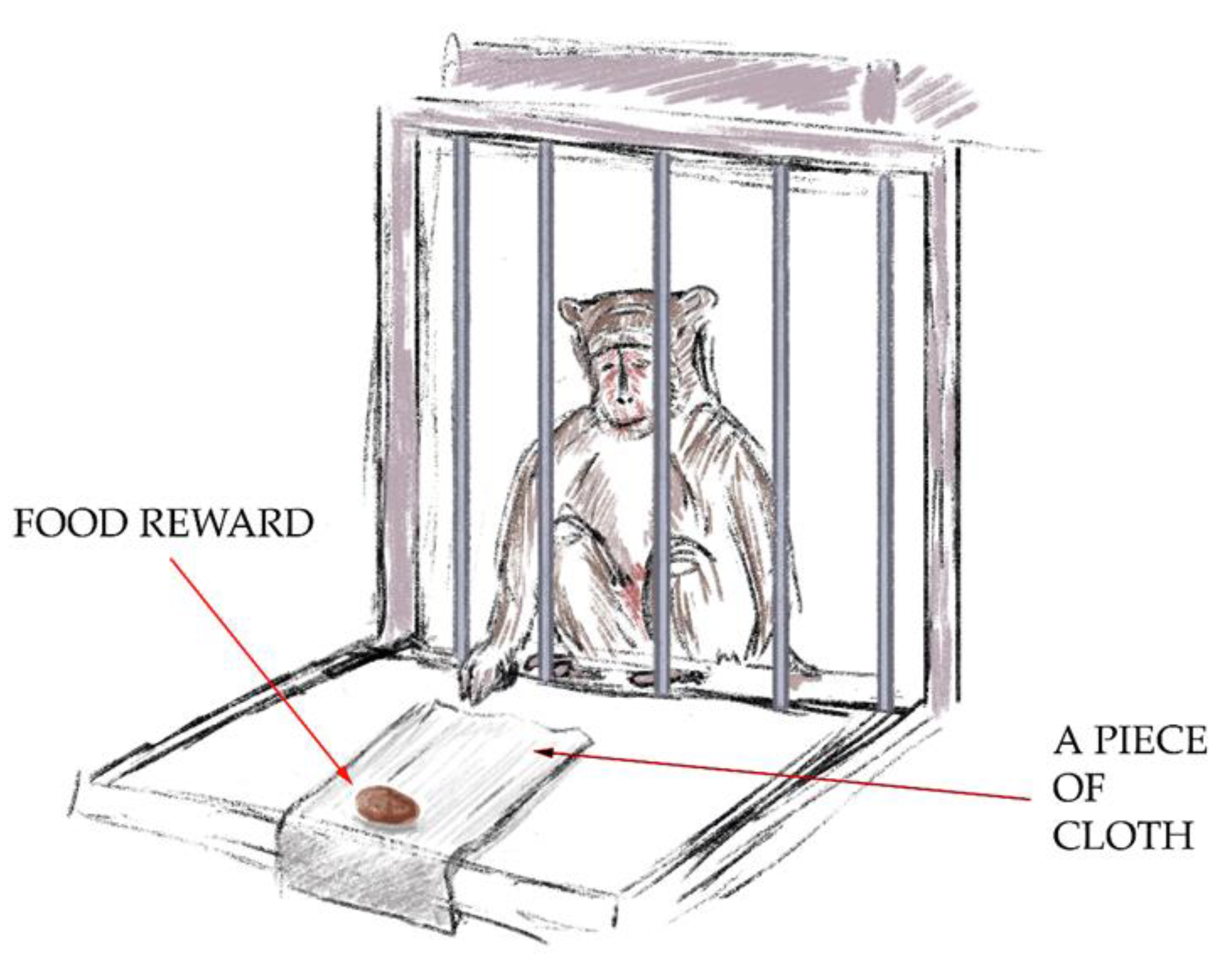

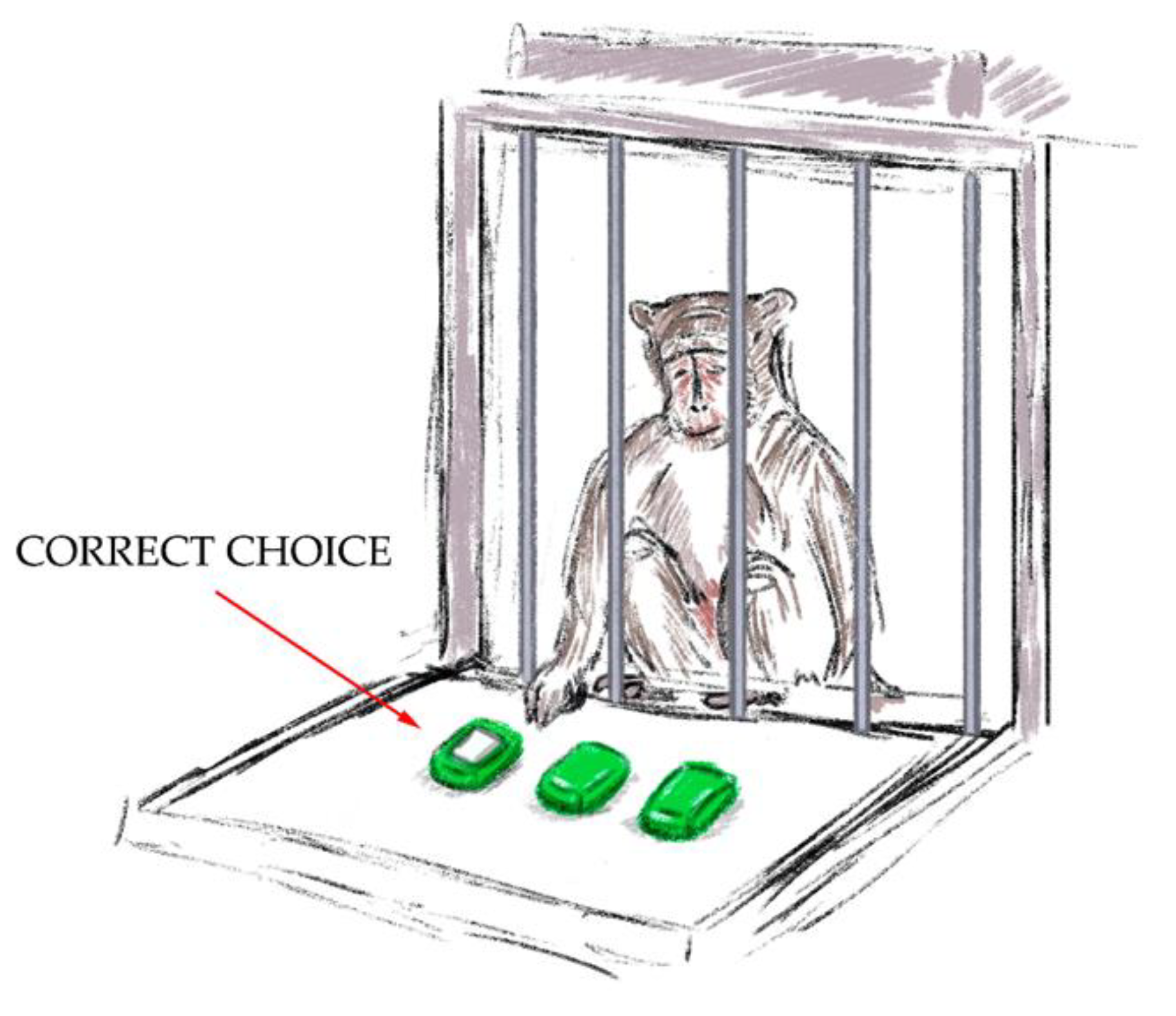
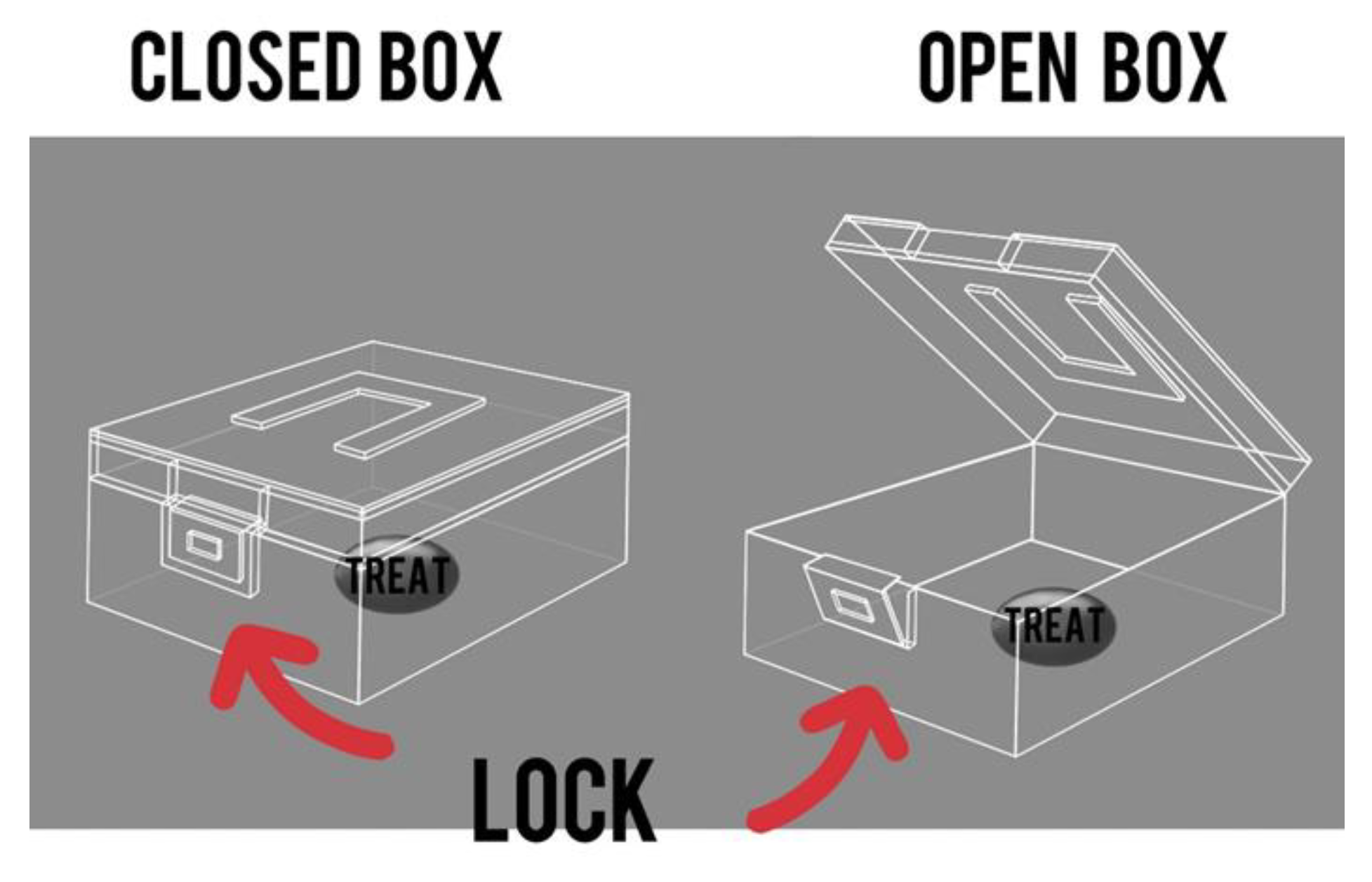
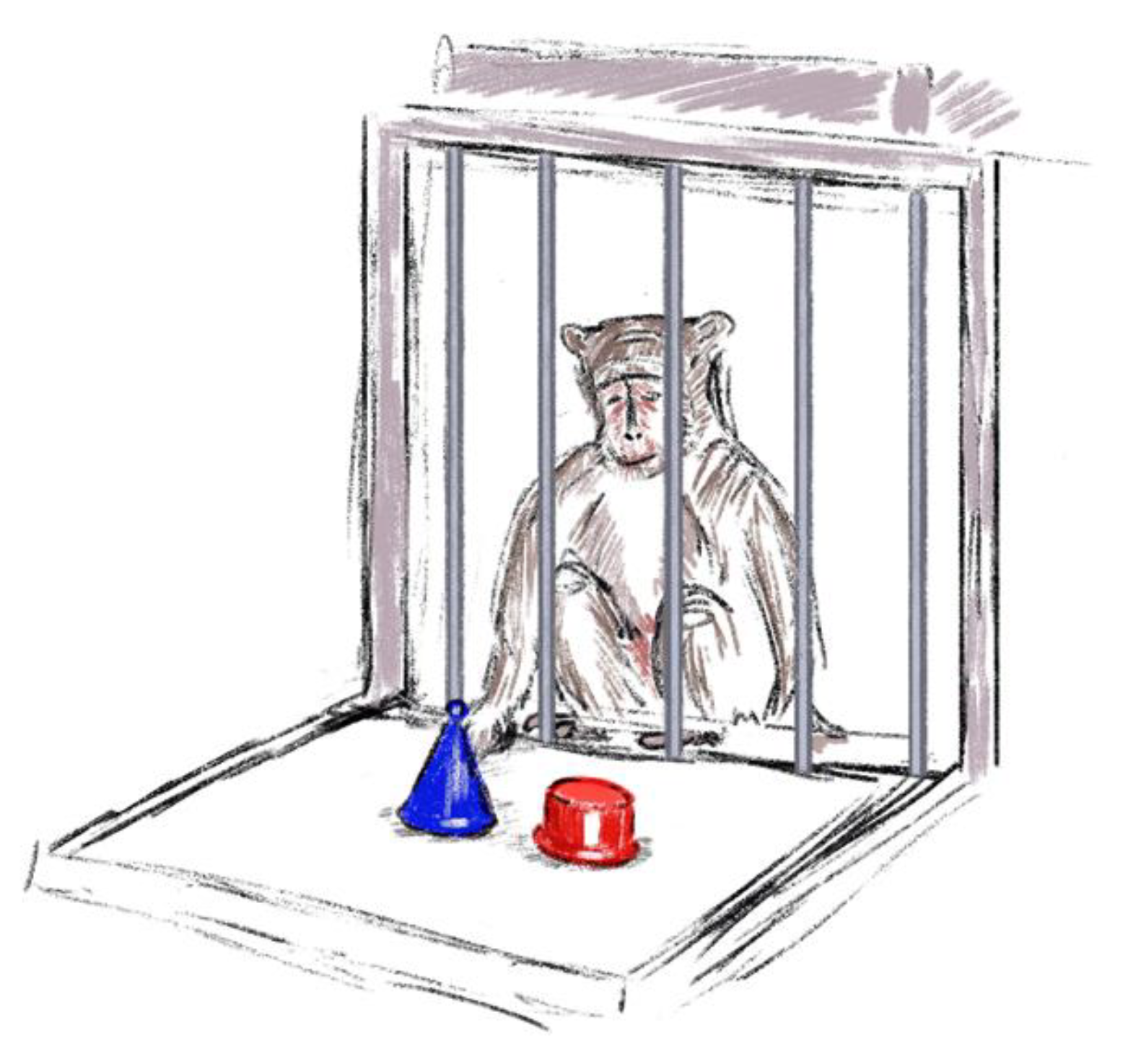
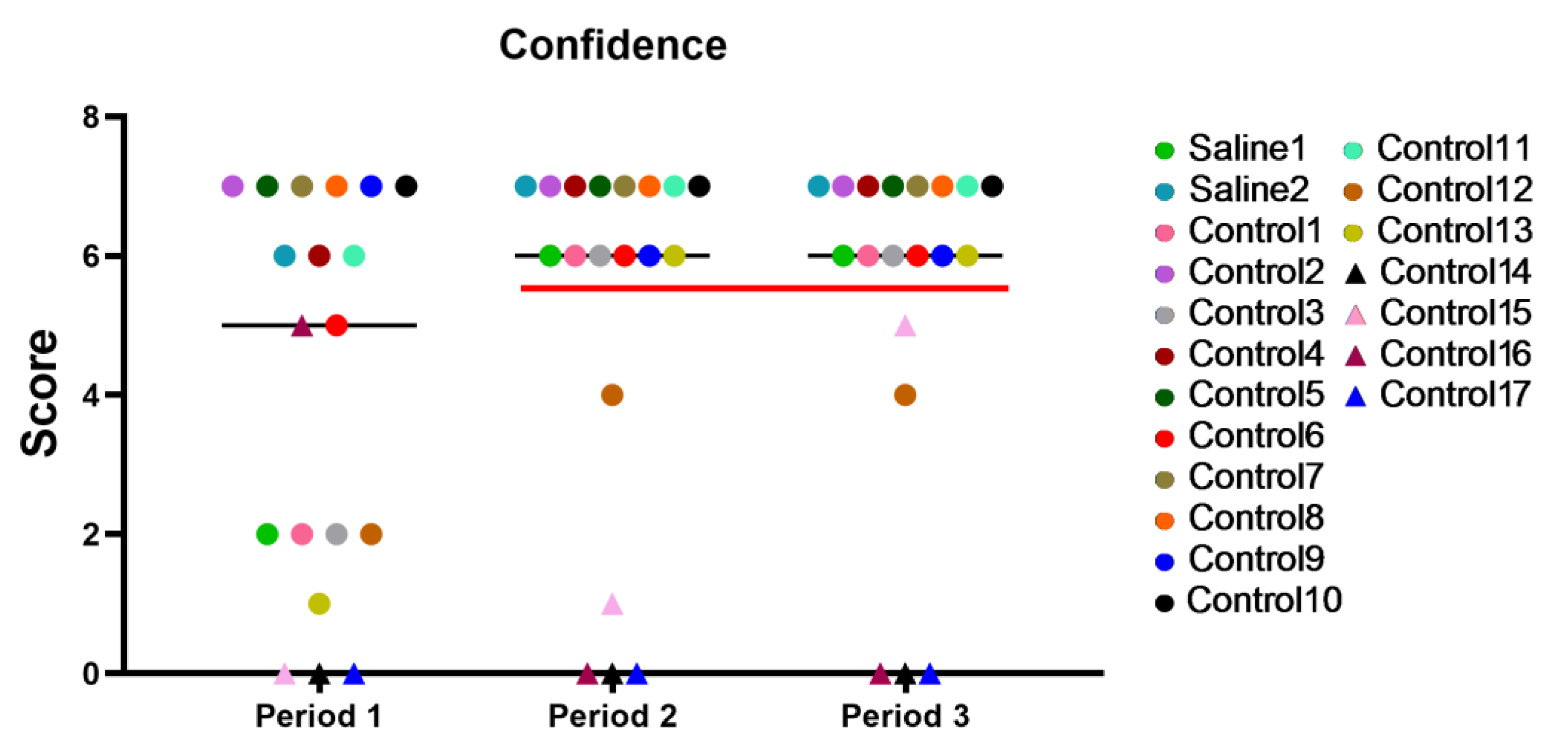

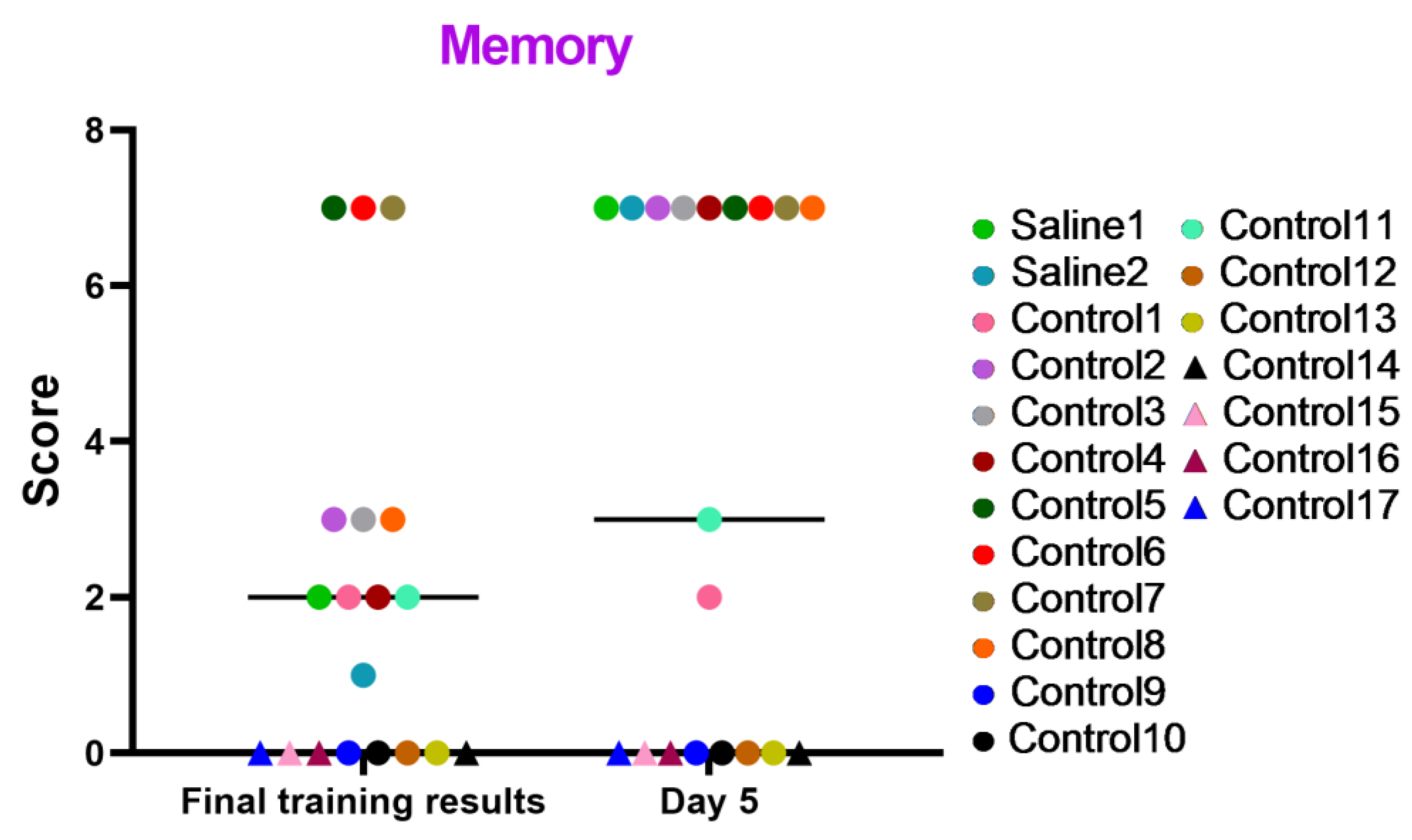
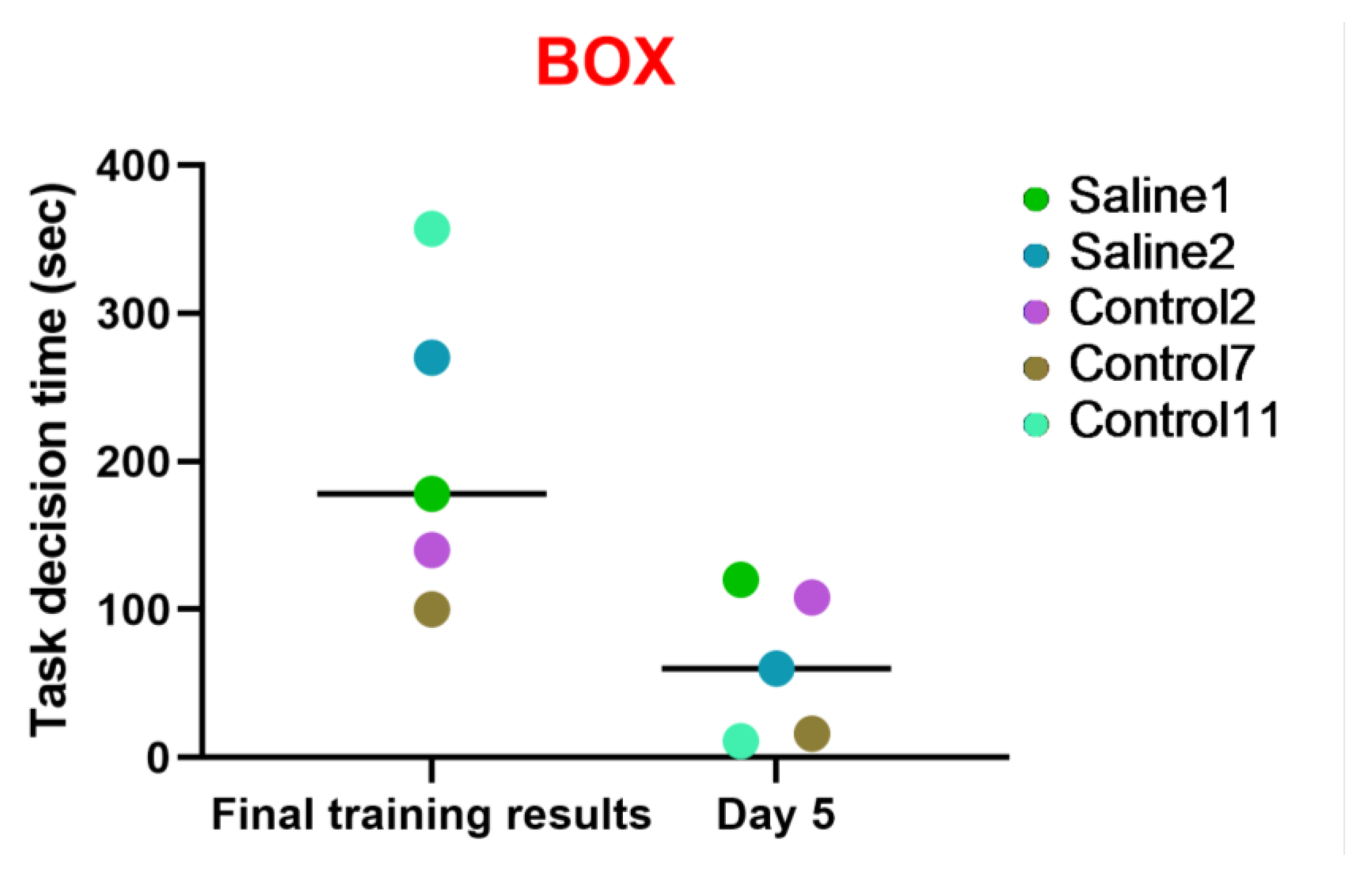


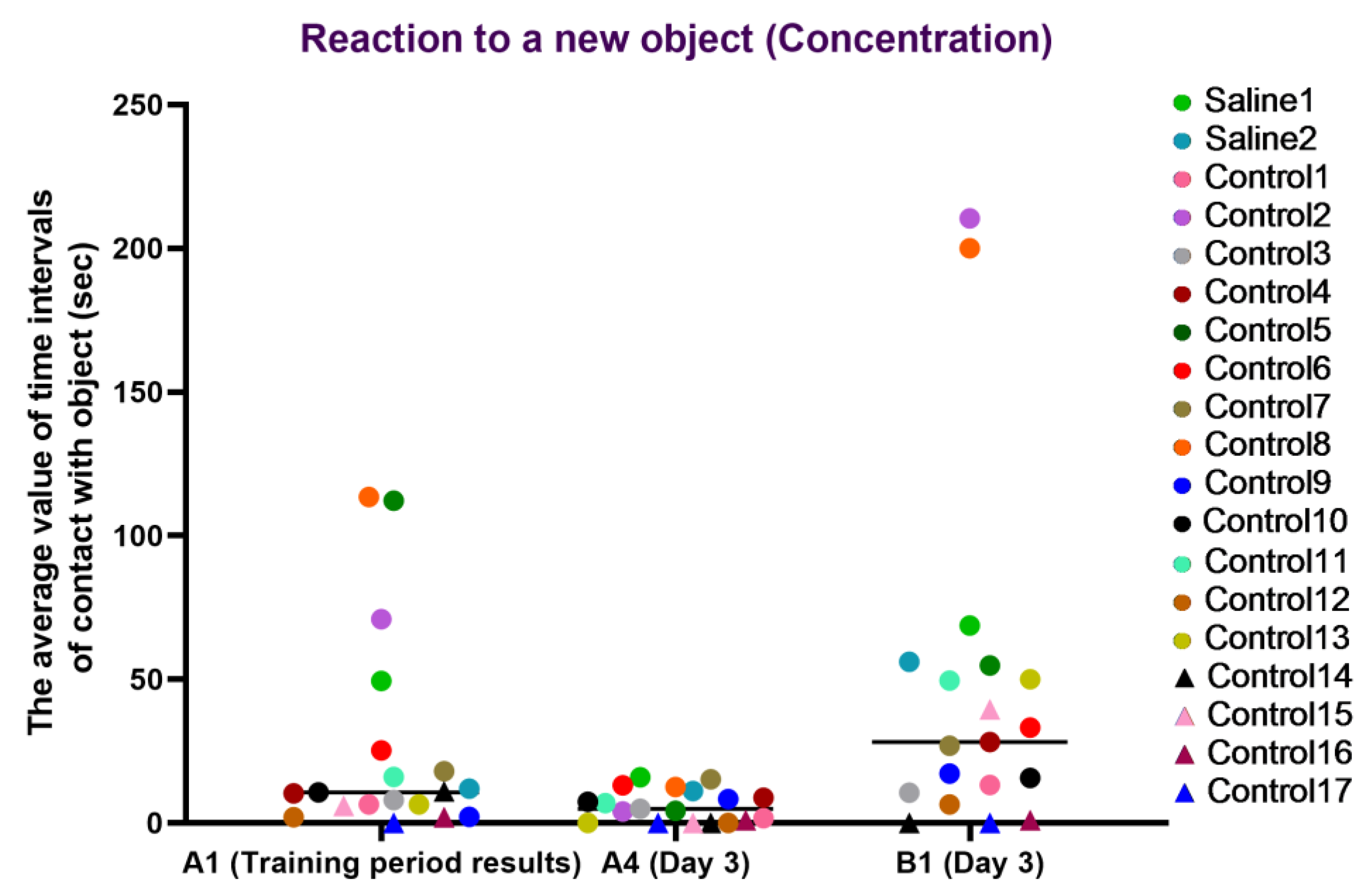
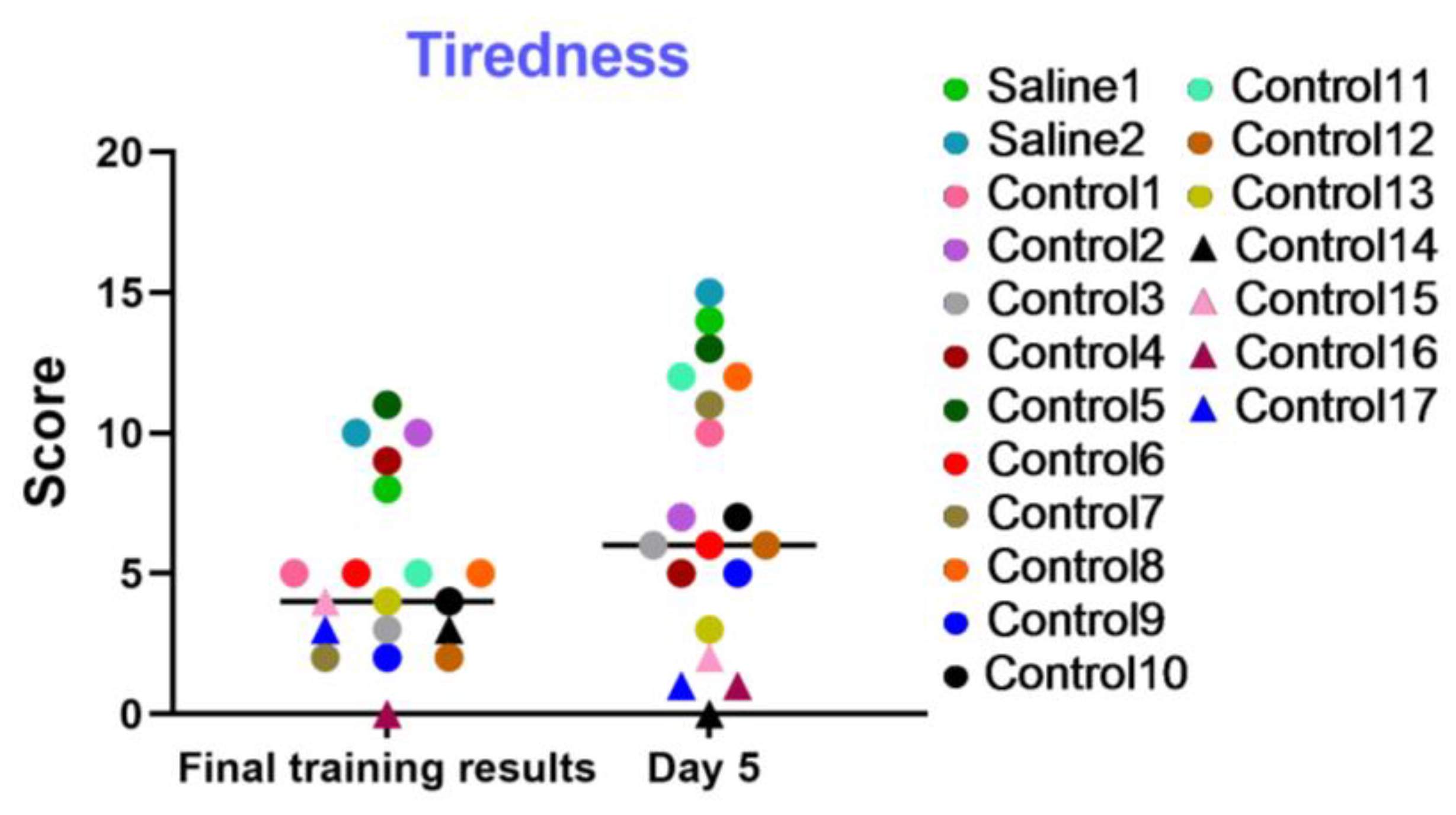
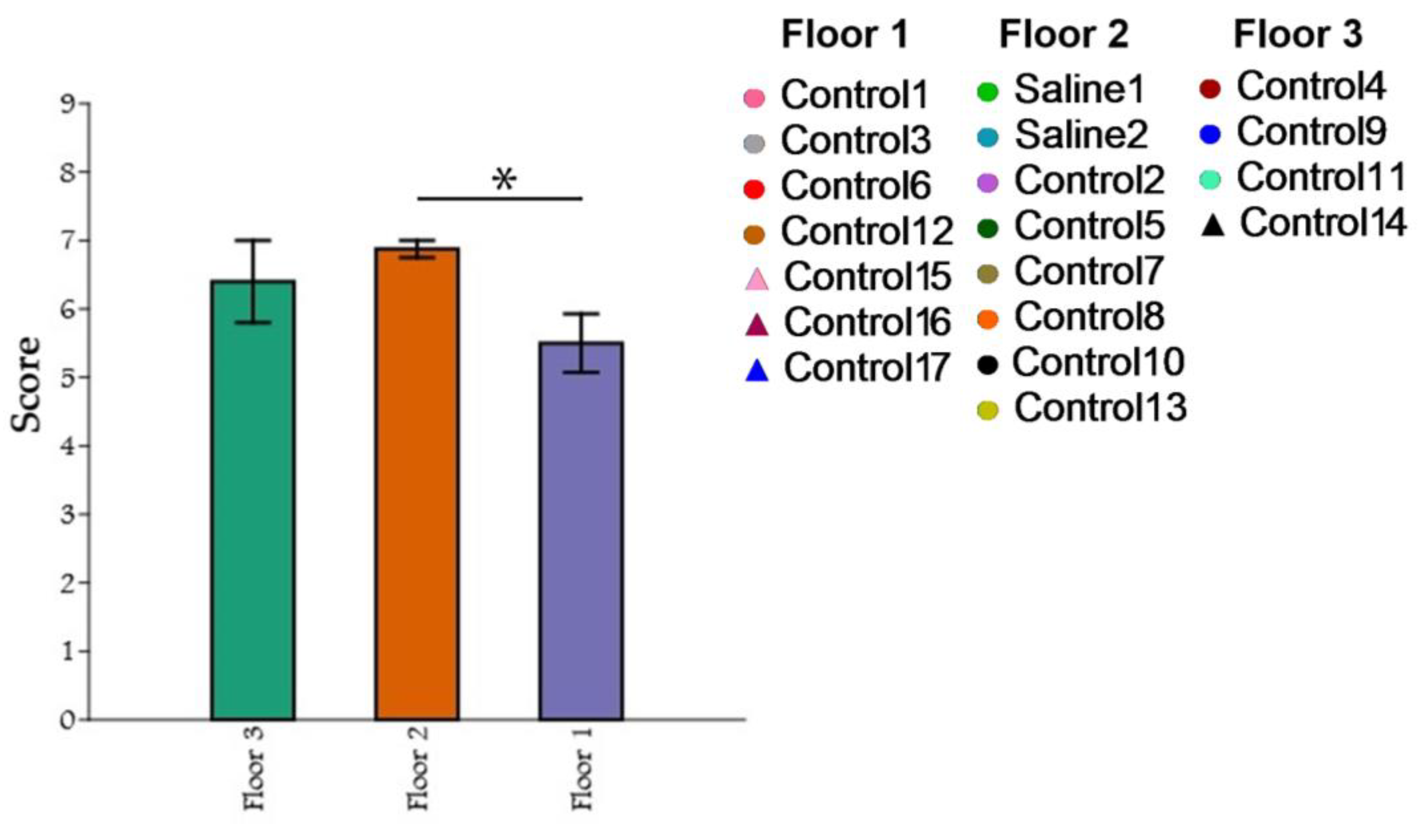
| Before Manipulations | Day 3 Post-Manipulations’ Start |
|---|---|
| A1—The initial exposition of object A (red cylinder), at the beginning of the training period | B1—The initial exposition of object B (blue cone), which was presented as a novel object after medical manipulations, with the object that was previously known (A4) (red cylinder; the fourth exposition of object A) |
| A2—The second exposition of object A (red cylinder), 10 days after the exposition of object A1 | |
| A3—The third exposition of object A (red cylinder), the day after the exposition of object A2 |
| Correlation Coefficient (τ) | Significance Level (p) | |
|---|---|---|
| Confidence Period 1: total score in behavioral tests | 0.50594 | 0.0024714 * |
| Confidence Period 2: total score in behavioral tests | 0.5773 | 0.00054767 * |
| Confidence Period 3: total score in behavioral tests | 0.82009 | 0.00044573 * |
| Male Floor 3 | Female Floor 3 | Male Floor 2 | Female Floor 2 | |
|---|---|---|---|---|
| Male floor 3 | 0.3102 | 0.7234 | 0.8891 | |
| Female floor 3 | 0.3102 | 0.48 | 0.383 | |
| Male floor 2 | 0.7234 | 0.48 | 0.8387 | |
| Female floor 2 | 0.8891 | 0.383 | 0.8387 |
| Memory | Tool Use and Properties | Tiredness | ||||
|---|---|---|---|---|---|---|
| U-Statistic | p-Value | U-Statistic | p-Value | U-Statistic | p-Value | |
| Males (n = 10) vs. females (n = 9) | 40.5 | 0.6076 | 30 | 0.22768 | 38 | 0.59185 |
Disclaimer/Publisher’s Note: The statements, opinions and data contained in all publications are solely those of the individual author(s) and contributor(s) and not of MDPI and/or the editor(s). MDPI and/or the editor(s) disclaim responsibility for any injury to people or property resulting from any ideas, methods, instructions or products referred to in the content. |
© 2024 by the authors. Licensee MDPI, Basel, Switzerland. This article is an open access article distributed under the terms and conditions of the Creative Commons Attribution (CC BY) license (https://creativecommons.org/licenses/by/4.0/).
Share and Cite
Rogova, A.; Kalyanova, A.; Rogova, Y.; Fedina, M.; Siniugina, A.; Ishmukhametov, A.; Karganova, G. An Integrative Approach to the Study of Cognitive Abilities in a Non-Human Primate Model in a Virology Laboratory Environment. Brain Sci. 2024, 14, 635. https://doi.org/10.3390/brainsci14070635
Rogova A, Kalyanova A, Rogova Y, Fedina M, Siniugina A, Ishmukhametov A, Karganova G. An Integrative Approach to the Study of Cognitive Abilities in a Non-Human Primate Model in a Virology Laboratory Environment. Brain Sciences. 2024; 14(7):635. https://doi.org/10.3390/brainsci14070635
Chicago/Turabian StyleRogova, Anastasia, Anna Kalyanova, Yulia Rogova, Maria Fedina, Alexandra Siniugina, Aydar Ishmukhametov, and Galina Karganova. 2024. "An Integrative Approach to the Study of Cognitive Abilities in a Non-Human Primate Model in a Virology Laboratory Environment" Brain Sciences 14, no. 7: 635. https://doi.org/10.3390/brainsci14070635
APA StyleRogova, A., Kalyanova, A., Rogova, Y., Fedina, M., Siniugina, A., Ishmukhametov, A., & Karganova, G. (2024). An Integrative Approach to the Study of Cognitive Abilities in a Non-Human Primate Model in a Virology Laboratory Environment. Brain Sciences, 14(7), 635. https://doi.org/10.3390/brainsci14070635






